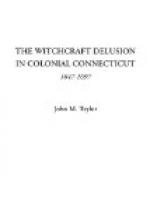Under this law, and the methods of its administration, witchcraft so called increased; persecutions multiplied, especially under the Commonwealth, and notably in the eastern counties of England, whence so many of all estates, all sorts and conditions of men, had fled over seas to set up the standard of independence in the Puritan colonies.
Many executions occurred in Lancashire, in Suffolk, Essex, and Huntingdonshire, where the infamous scoundrel “Witch-finder-General” Matthew Hopkins, under the sanction of the courts, was “pricking,” “waking,” “watching,” and “testing” persons suspected or accused of witchcraft, with fiendish ingenuity of indignity and torture. Says James Howell in his Familiar Letters, in 1646:
“We have multitudes of witches among us; for in Essex and Suffolk there were above two hundred indicted within these two years, and above the half of them executed.”
“Within the compass of two years (1645-7), near upon three hundred witches were arraigned, and the major part of them executed in Essex and Suffolk only. Scotland swarms with them more and more, and persons of good quality are executed daily.”
Scotland set its seal on witchcraft as a crime by an act of its parliament so early as 1563, amended in 1649. The ministers were the inquisitors and persecutors. They heard the confessions, and inflicted the tortures, and their cruelties were commensurate with the hard and fast theology that froze the blood of mercy in their veins.
The trials were often held by special commissions issued by the privy council, on the petition of a presbytery or general assembly. It was here that those terrible instruments of torture, the caschielawis, the lang irnis, the boot and the pilliewinkis, were used to wring confessions from the wretched victims. It is all a strange and gruesome story of horrors told in detail in the state trial records, and elsewhere, from the execution of Janet Douglas—Lady Glammis—to that of the poor old woman at Dornoch who warmed herself at the fire set for her burning. So firmly seated in the Scotch mind was the belief in witchcraft as a sin and crime, that when the laws against it were repealed in 1736, Scotchmen in the highest stations of church and state remonstrated against the repeal as contrary to the law of God; and William Forbes, in his “Institutes of the Law of Scotland,” calls witchcraft “that black art whereby strange and wonderful things are wrought by a power derived from the devil.”
This glance at what transpired on the continent and in England and Scotland is of value, in the light it throws on the beliefs and convictions of both Pilgrim and Puritan—Englishmen all—in their new domain, their implicit reliance on established precedents, their credulity in witchcraft matters, and their absolute trust in scriptural and secular authority for their judicial procedure, and the execution of the grim sentences of the courts, until the revolting work of the accuser and the searcher, and the delusion of the ministers and magistrates aflame with mistaken zeal vanished in the sober afterthought, the reaction of the public mind and conscience, which at last crushed the machinations of the Devil and his votaries in high places.




